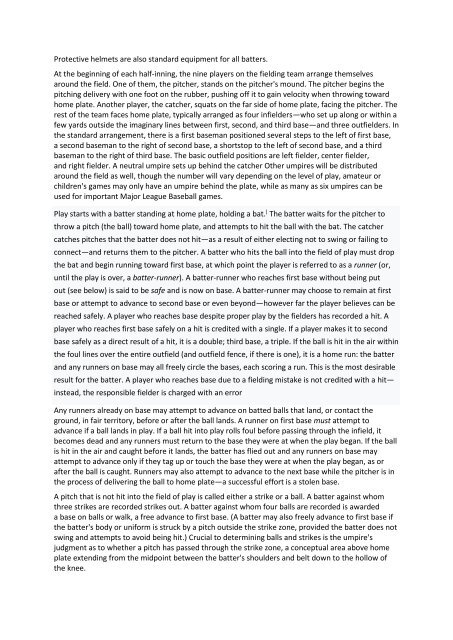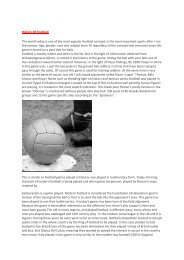Dergi
Create successful ePaper yourself
Turn your PDF publications into a flip-book with our unique Google optimized e-Paper software.
Protective helmets are also standard equipment for all batters.<br />
At the beginning of each half-inning, the nine players on the fielding team arrange themselves<br />
around the field. One of them, the pitcher, stands on the pitcher's mound. The pitcher begins the<br />
pitching delivery with one foot on the rubber, pushing off it to gain velocity when throwing toward<br />
home plate. Another player, the catcher, squats on the far side of home plate, facing the pitcher. The<br />
rest of the team faces home plate, typically arranged as four infielders—who set up along or within a<br />
few yards outside the imaginary lines between first, second, and third base—and three outfielders. In<br />
the standard arrangement, there is a first baseman positioned several steps to the left of first base,<br />
a second baseman to the right of second base, a shortstop to the left of second base, and a third<br />
baseman to the right of third base. The basic outfield positions are left fielder, center fielder,<br />
and right fielder. A neutral umpire sets up behind the catcher Other umpires will be distributed<br />
around the field as well, though the number will vary depending on the level of play, amateur or<br />
children's games may only have an umpire behind the plate, while as many as six umpires can be<br />
used for important Major League Baseball games.<br />
Play starts with a batter standing at home plate, holding a bat. ] The batter waits for the pitcher to<br />
throw a pitch (the ball) toward home plate, and attempts to hit the ball with the bat. The catcher<br />
catches pitches that the batter does not hit—as a result of either electing not to swing or failing to<br />
connect—and returns them to the pitcher. A batter who hits the ball into the field of play must drop<br />
the bat and begin running toward first base, at which point the player is referred to as a runner (or,<br />
until the play is over, a batter-runner). A batter-runner who reaches first base without being put<br />
out (see below) is said to be safe and is now on base. A batter-runner may choose to remain at first<br />
base or attempt to advance to second base or even beyond—however far the player believes can be<br />
reached safely. A player who reaches base despite proper play by the fielders has recorded a hit. A<br />
player who reaches first base safely on a hit is credited with a single. If a player makes it to second<br />
base safely as a direct result of a hit, it is a double; third base, a triple. If the ball is hit in the air within<br />
the foul lines over the entire outfield (and outfield fence, if there is one), it is a home run: the batter<br />
and any runners on base may all freely circle the bases, each scoring a run. This is the most desirable<br />
result for the batter. A player who reaches base due to a fielding mistake is not credited with a hit—<br />
instead, the responsible fielder is charged with an error<br />
Any runners already on base may attempt to advance on batted balls that land, or contact the<br />
ground, in fair territory, before or after the ball lands. A runner on first base must attempt to<br />
advance if a ball lands in play. If a ball hit into play rolls foul before passing through the infield, it<br />
becomes dead and any runners must return to the base they were at when the play began. If the ball<br />
is hit in the air and caught before it lands, the batter has flied out and any runners on base may<br />
attempt to advance only if they tag up or touch the base they were at when the play began, as or<br />
after the ball is caught. Runners may also attempt to advance to the next base while the pitcher is in<br />
the process of delivering the ball to home plate—a successful effort is a stolen base.<br />
A pitch that is not hit into the field of play is called either a strike or a ball. A batter against whom<br />
three strikes are recorded strikes out. A batter against whom four balls are recorded is awarded<br />
a base on balls or walk, a free advance to first base. (A batter may also freely advance to first base if<br />
the batter's body or uniform is struck by a pitch outside the strike zone, provided the batter does not<br />
swing and attempts to avoid being hit.) Crucial to determining balls and strikes is the umpire's<br />
judgment as to whether a pitch has passed through the strike zone, a conceptual area above home<br />
plate extending from the midpoint between the batter's shoulders and belt down to the hollow of<br />
the knee.




